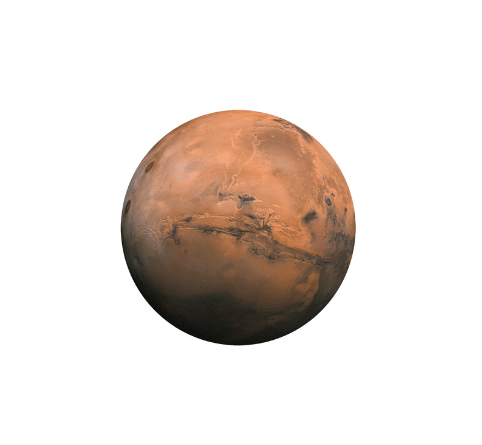Mars is a rocky planet in the Solar System. It is called the Red Planet because its surface is covered with dust rich in iron oxide, giving it a reddish colour. The planet also features many large volcanoes and deep canyons.
Mars has two small known natural satellites: Phobos and Deimos. These are much smaller compared to the moons of other planets and are believed to be asteroids captured by Mars’ gravity.
Mars is named after the Roman god of war, a reference to its red colour, which resembles the blood spilled in battle.

| Caractéristiques | Mars | Terre |
| Diamètre | 6 780 km | 12 750 km |
| Rapport de masse | 0,11 | 1 |
| Rapport de gravité | 0,38 | 1 |
| Distance de soleil (UA) | 1,52 | 1 |
| Inclinaison / Axe de rotation | 25,2° | 23,5° |
| Période de rotation | 24,7 j | 1 j |
| Révolution autour du soleil | 687 j | 365 j |
| Température max | +20°C | +58°C |
| Température min | -143°C | -89°C |
| Lunes | 2 | 1 |
Mars is often called the “Red Planet” because it appears in the sky as a reddish-orange star. This colour is the reason the ancient Greeks and Romans named it after their god of war.
The formation of Mars, the fourth planet from the Sun, is similar to that of the other terrestrial planets like Earth, although there are differences in the details.
- Mars formed from the same protoplanetary disc made up of gas, dust, and debris that gave birth to the solar system around 4.6 billion years ago.
- Solid particles in the disc began to clump together under the effect of gravity, forming small rocky bodies. These bodies then gathered to form planetary embryos, which continued to grow.
- As Mars’ planetary embryo continued to grow, it began to differentiate into distinct layers, forming the core, mantle, and crust.
- As Mars continued to form and accumulate mass, it began to clear its orbit by absorbing or ejecting surrounding debris. This process left Mars with a relatively stable orbit around the Sun.
- Once Mars had reached a sufficient mass, it became a fully-fledged planet. Although smaller than Earth, Mars has a similar composition with a core of iron and nickel, a rocky mantle, and a solid crust.
- Over time, Mars underwent climatic and geological changes, including the formation of massive volcanoes, large valleys, and ice caps.
- Although Mars likely had liquid water on its surface in the past, it is now mainly in the form of ice or vapour.
- While summers near its equator can be very hot, the average temperature is –63°C, similar to Antarctic winters. Nights there are also extremely cold. Violent storms can raise dust clouds, which sometimes spread very quickly around the entire planet, obscuring its surface.
The formation of Mars is part of the broader picture of the formation of terrestrial planets in our solar system, although the exact details of its history remain subjects of debate and scientific research.
It orbits the Sun at an average distance of 228 million km, which is one and a half times farther than Earth.
For more information, you can visit the following websites:
